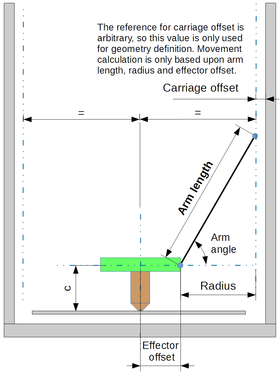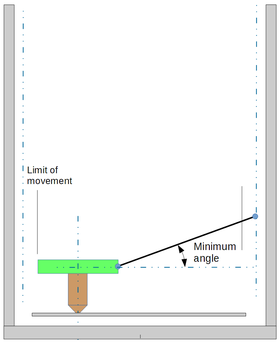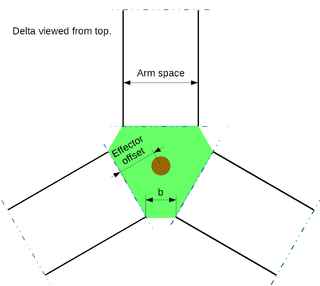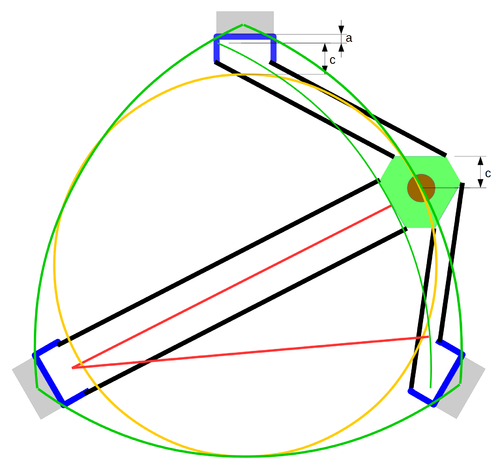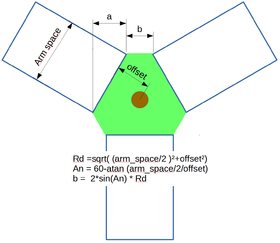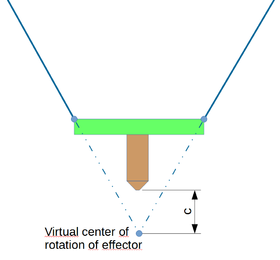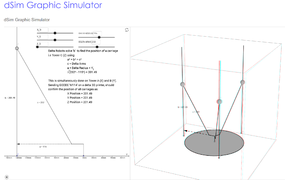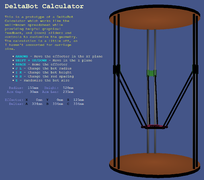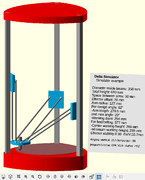Delta geometry
Contents
Presentation
A 'delta' robot or printer is a robot where a platform is maintained by three pair of arms set in a triangle. The pairs of parallel arms maintain the horizontality of the platform and the movement of these arms displace the platform in the three dimensions. Many solutions exists, but a few are used practically.
There are two principles to displace the arms pairs:
- Each arms pairs are installed on a main articulated arm, the movement being generated be the rotation of this main arm. The geometry is the rotational delta or 'Clavel delta' from the name of its inventor. The principle is widely used on 'pick and place' machine in a wide range of industries, from electronic to food. This system can be found in the Delta by Energetic or on the FirePick Delta printers.
- Arms pairs are attached to carriage sliding along parallel rails. This geometry is called 'linear delta' and is the most frequent type used in 3D printer world, the machines originating the movement being the 'Rostock' and the 'Kossel'. The term 'parallel delta' shall not be used as all robots with parallel arms are called [parallel robots].
There is another solution without rigid mechanics which is to suspend the platform to wires. There are a few examples and notably the Skydelta or this suspended delta
The linear delta kinematic calculation is simple because the carriage follow a straight line, so the horizontal movement of the platform is linked to the vertical movement of the carriage by Pythagorean theorem (which say that the square of the diagonal of a rectangle triangle is equal to the sum of the square of its sides). Here the diagonal is the arm length, constant, the vertical branch is the relative vertical position of the platform and carriage, the horizontal branch is the relative horizontal position of the platform and carriage. The math is not difficult, but for a printer a lot of square roots shall be done and control board based on 8 bit processors are struggling doing this calculation, so a lot of fine software optimization were done for the delta geometry for these processors.
It shall be noted that the sliders columns can be on a non-equilateral triangle and asymmetric dispositions were tested, notably the 'Square' delta with angles of 90°,90° and 180°.
Geometry of a linear delta
Schematics
The arm angle with effector at center is the result of the arms length, minimum angle and angles of the arms while at maximum diameter. For minimum angle of 20°, this angle is around 60° for maximum diameter arm verticals, but if the minimum angle is increased, it may be higher. Minimum angles of 22° will gives an angle of 63° with vertical arms.
Arms may not be able to reach the vertical due to clearance problem, notably with the part cooling fans or effector accessories. In that case, for a given minimum angle, arm length may be reduced and the angle while effector is at center will be lower.
On the other way, some printers have arms capable to go over vertical (e.g. Rostock Max).
The minimum arm angle, while effector is at maximum diameter, is one of the basic design parameters. It is important for effector stability, precision and carriage speed. A low angle induce high carriage speed for a given effector horizontal speed. Low angle also decrease effector stability. Generally, 20° angle is considered as a practical minimum and induce a carriage speed 2.75 times higher than effector horizontal speed. Some printers with theoretical minimum angle of 15° may experience lost steps at their maximum diameter.
Arm space does not influence movement calculation, but have an importance for the effector stability. Best stability is obtained for the minimum offset, with the maximum possible arm space for this offset (minimising b dimension).Reachable area
For a given minimum angle, the reachable area is a triangle with bulged sides, with the ends of the triangle oriented toward the columns, which cannot be accessed without impacting the column. Then, for simplicity, the reachable area is generally considered circular. It might be interesting to evaluate the real reachable area when one want to inscribe a rectangle or square in the printing area. The accessories (belts and fans) are critical for the real usable area.
Schematic
- Green : the area which may be reachable without obstacle
- Orange : the practical area taking into account the clearance required between effector and columns.
Effector stability
What is effector stability ?
This is the fact that an effector resist to tilting moments. The tilt may displace the hotend nozzle and creates imprecision. It also have an effect on level measurement sensor while the sensors are offset from the hotend. Two things have important effect on an effector stability:
- The geometry, as different geometries may induce higher or lower loads on arms and articulation, so higher or lower deformation. A geometry reducing the load will increase precision.
- The moment resistance induced by arm articulation, say a cardan will resist to torsion induced by the effector, while ball articulation will not.
The moment which will induce tilt will be created by :
- Inertia
- Load on the nozzle
- Friction in articulation, which may be significant for some types of articulations.
How to improve geometry
- A small offset will reduce the load on arms/articulation for a moment and shall be researched.
- For a given offset, the distance between the centers of articulation (noted 'b' on drawing) will modify the moment created by side loads. The lower this space, the better the stability. When these articulation are merged, the geometric stability is very important, as there is no possible level difference in the merged articulations, hence, no possibility to have an 'articulated' tilt. This solution is used by example on the Spiderbot delta.
Position of the hotend
What is also very important is the position of the hotend to minimize the effect of effector tilt. Any platform suspended to articulated rods will rotate around a virtual point located at the convergence of rod axis. Manipulating manually an effector show this effect, as (if there is no hotend) the effector tend to rotate around the middle of your palm and not at the middle of the effector.
Unfortunately, for constructive reasons, the hotend being located above or below the effector, the nozzle is rarely near this ideal location. It shall be noted that the location of this virtual articulation is not constant and move while the effector is displacing, but the nozzle may be placed at an average best place.
Quantifying the effects of the geometrical stability: TES coefficient
Understanding that there are other causes that the effector stability to nozzle movement imprecision, it is however interesting to quantify the displacement due to geometrical instability.
A coefficient could be defined, that we may called TES, for tilt effector stability, which will not quantify the effector instability, but its effect on the hotend, by combining the moment effect and the displacement related to the distance between the virtual articulation and the nozzle location.
a being the lever due to arm space (see drawing) b being the space between balls (articulations) c being the space between hotend nozzle and arms axis crossing (virtual articulation)
- Tilt geometric load moment is related to a/b, a being proportional to arm space
- Tilt stiffness is proportional to arm space
- Effect of tilting is proportional to c (distance between arm convergence and hotend nozzle)
TES = (Arm space)²/b/abs(c), with c defined at center and at maximum radius. So there will be TESc (at center) and TESr (at max radius). Yet only TESc is calculated in the simulator.
It is important to note that the TES does not depend from arm length, only effector geometry. Indeed, the arm stiffness in their axis is huge compared to other elements, notably articulation stiffness, so the arm length have nearly no effect on tilting stability. This is why you could install the small Kossel mini effectors on large printers without problems. It shall be noted that for merged articulations, this coefficient will be infinite.
It may be defined at center (TESc) or at the maximum radius (TESr).
This coefficient is calculated in the OpenScad delta simulator.
Values for some deltas :
- Kossel (with J-head); TESc : 18 : hotend 8mm below virtual articulation
- Rostock Max; TESc : 1.8 : hotend is way above virtual articulation (> 40mm), offset is large. It is important to note that the Rostock Max have cardan articulations, which may compensate the geometrical instability.
- Fisher; TESc : 9 :While hotend is 18mm above virtual articulation, the low space between balls at the effector end helps stability.
- Micro-delta; TESc : 1.3 : hotend 48 mm above virtual articulation, large offset, large space between balls contribute to a low stability.
- D-Box; TESc : 28 : hotend nozzle is 25mm above virtual articulation (with two nuts on the Prometheus hotend), however, the large arm space (84mm) coupled with very low distance between balls at the angles (10 mm) gives a good stability, notable while manipulating the effector by hand. However, the friction of the articulations is significant and that creates a moment in the effector which is not taken into account in the TES. (disclosure: this is the printer of the author of this page, who also had a Fisher).
Interactive web simulation
Linear deltas
- GeoGebra dSim graphic simulator for linear delta, use sliders to adjust parameters. Can be viewed in 3D with red/blue glasses.
- Thinkyhead Deltabot calculator for linear delta, enter numbers for simulation.
Rotational deltas
- Parola Java based simulator, rotational delta with many options
- http://arvc.umh.es/label/delta.html
Simulation on software
- OpenScad delta simulator for linear delta with active simulation, with common printers datasets predefined. Change variables values for simulation. You can see a film here or here (Fisher Delta)
Delta calculators
Linear deltas
- http://www.heliumfrog.com/deltarobot/details/details.html Excel sheet calculator for linear delta
- https://github.com/Jaydmdigital/mk_visual_calc OpenScad calculator with visualization dedicated to Kossel
Rotational deltas
- marginally clever Online calculator
- Trossen robotics forum
Math and research papers
- http://robinsonia.com/wp/?p=161 math explanations for linear delta
- http://scholar.rose-hulman.edu/cgi/viewcontent.cgi?article=1000&context=mechanical_engineering_grad_theses Linear delta research paper, but with the sliders parallel to the effector plan.
Rotational delta are a quite common research topic, notably for university students.
- http://www.ohio.edu/people/williar4/html/pdf/DeltaKin.pdf Rotational delta kinematics.
Calculation links
- https://hackaday.io/project/963-firepick-delta-the-open-source-microfactory/log/3588-6152014-delta-mechanism-simulation-and-accuracy-determination (Rotational delta)
Simulation without source/access
Some people have done Delta simulation on CAD/Math software, but not publicly release them.
- https://www.youtube.com/watch?v=8_6QfZ6DJfU film of a Simulation with Matlab
- https://www.youtube.com/watch?v=K2zxvHq3iC8 film
- https://www.youtube.com/watch?v=OwI6hYHWbjw A python simulator, undisclosed program.
